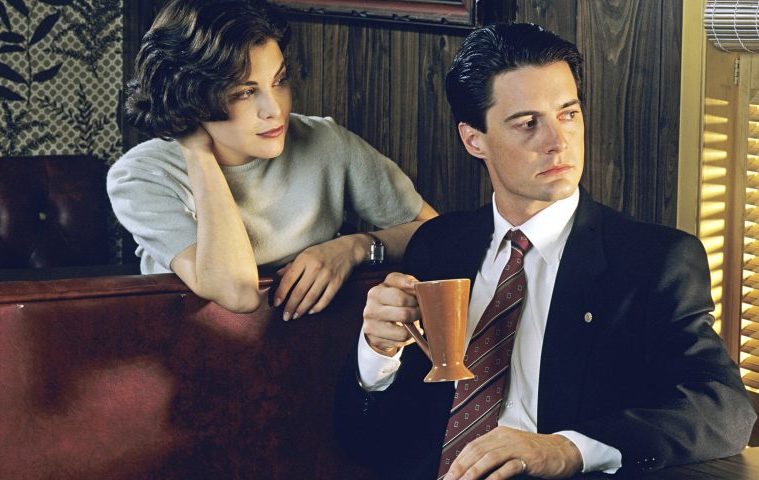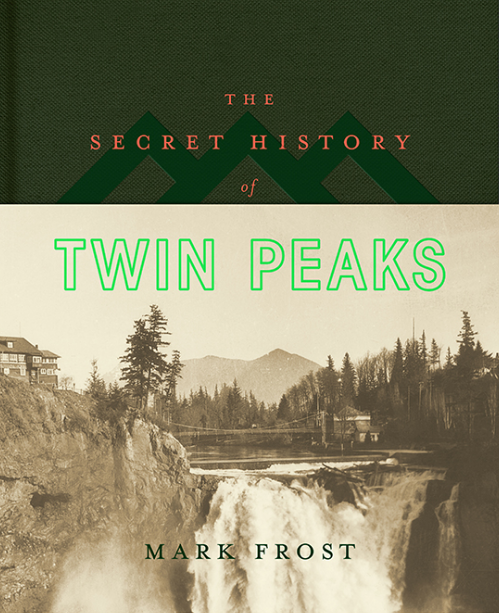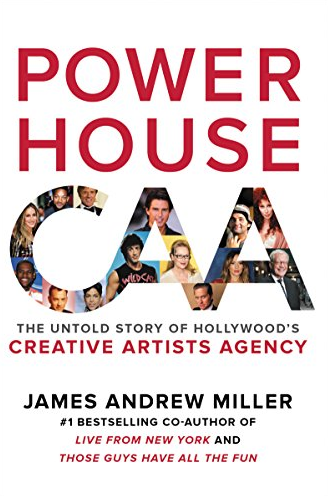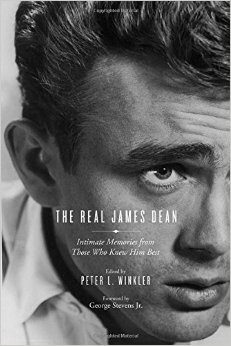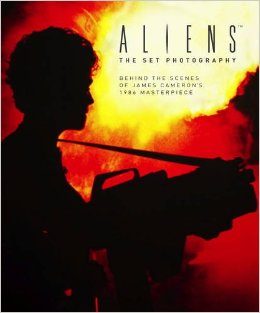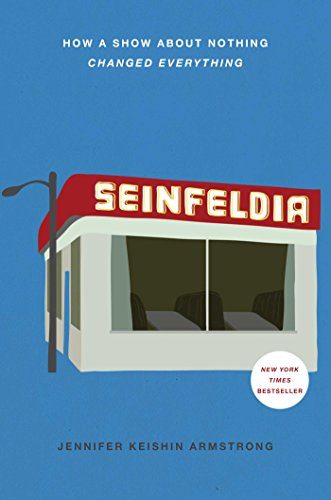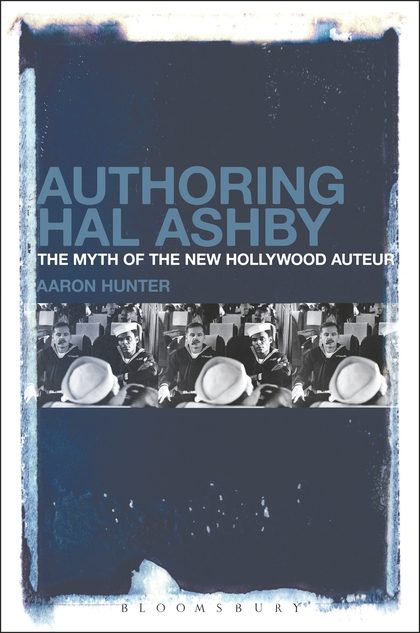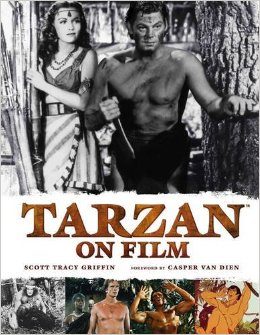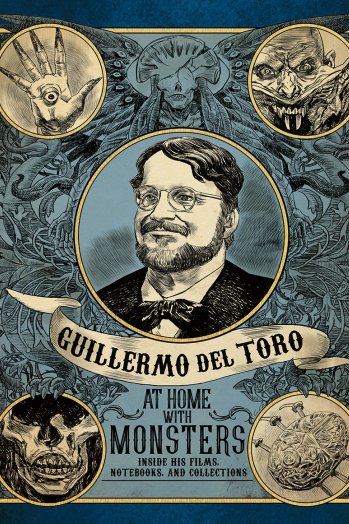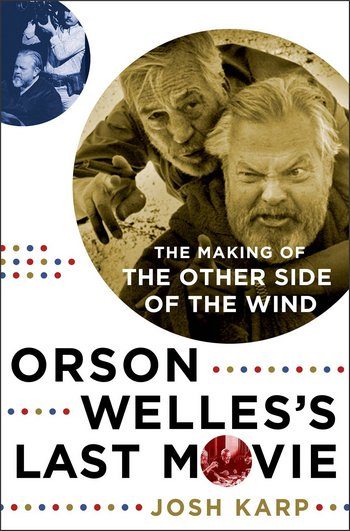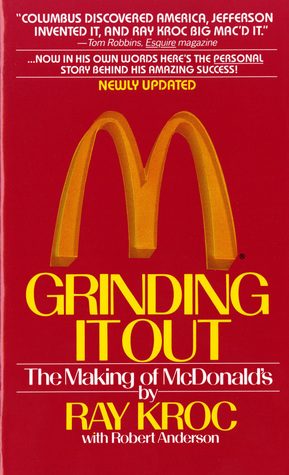
It’s time to head back to Twin Peaks, salute some major names (Gus Van Sant, James Cameron, Hal Ashby, Guillermo del Toro, Orson Welles), icons (James Dean), and (former) power players (Mike Ovitz). Plus, Harry Potter, Seinfeld, and McDonald’s! Let’s start with a loving look back at 50 years of the starship Enterprise.
Star Trek: 50 Artists 50 Years (Titan Books)
There have been a number of interesting books released to commemorate the 50th anniversary of Star Trek, but there’s no question that 50 Artists 50 Years is the handsomest. As the title makes clear, the premise is simple: 50 respected artists, all with wildly unique styles, were tasked with creating a work of art highlighting some element of the Trek universe. There’s plenty of original series — Glen Brogan’s jaunty representation of the bridge of the Enterprise is my personal favorite — and lots of Spock. Plus, Leonard Nimoy himself contributed a striking photo called “Hand in Vulcan Gesture.” The feature films and offshoot series are here, as well. There’s not a dud in the bunch; as Wrath of Khan director Nicholas Meyer puts it in the foreward, “What you are about to see surely merits an occasion for display.”
First tangible signs of Twin Peaks life in nearly a quarter-century are an enticing thing, and his book can be a beautiful one at that — especially in how this epistolary text’s design moves between journal entries, classified documents, newspaper articles, and annotations from an FBI agent who might become a new series regular. This is very much an indulgence of Frost’s interests, but that makes for a fulfillment of fans’ hopes. It’s commendable that he would do this, if not, ultimately, so satisfying for everyone that this was the choice, or so I’d think when reading page after page enmeshed in UFO conspiracies and weird history that feel largely disconnected from any tangible Twin Peaks narrative. Given that the forthcoming episodes were written before the book’s conception and, by Frost’s own admission, this project is entirely his doing, The Secret History of Twin Peaks might be best considered a fun diversion — a title it often fulfills really well. It thus makes sense that the book proves most engaging when moving past the original series’ events, including post-finale references to Dale Cooper (himself the author of certain sections) so vague that they’ve started driving me mad. What’s this about files “that are designated many levels above top secret”? Canon or not, Secret History can put wind in my sails with as little as a sentence fragment. – Nick N.
Those fascinated by behind-the-scenes entertainment biz maneuvering will devour Powerhouse, an epic oral history of the talent agency that changed the industry, Creative Artists Agency. Like James Andrew Miller’s previous efforts about ESPN and Saturday Night Live, the sheer number of interviewees is staggering and diverse. Here, you’ll find everyone from David Letterman and Bill Murray to LeBron James and Michael Bolton. (Of course.) But the most fascinating figure is CAA founder Michael Ovitz. Miller looks closely at Ovitz’s dealings with co-founder Ron Meyer, his move to Disney, and stunning fall from grace, and hearing Ovitz’s first-hand account is a treat. There is great humor here, and also real emotion, much of it centered around the shocking death of “young turk” agent Jay Moloney. If you have any interest in show business, Powerhouse is an absolute must-read.
Is Peter L. Winkler’s The Real James Dean the most intimate chronicle of the late icon ever written? That’s entirely possible, thanks to a bold, unique approach. Winkler collects first-hand accounts from a large, diverse group of Dean’s coworkers, friends, contemporaries, and lovers — Natalie Wood, Nicholas Ray, Eliz Kazan, Hedda Hopper, Jim Backus — and the result is fascinatingly insightful. There are surprising appearances (from Ray: “Late one evening, he arrived at my house … with ‘Vampira,’ the television personality”), heartbreaking memories (Alec Guinness tells of an encounter with dean just a week before his death), and numerous reminders that Dean’s personality was truly electric. Winkler, the author of an acclaimed biography of Dennis Hopper, calls this “the first book of its kind.” It’s certainly that, and it’s also an indispensable text for anyone interested in Dean, Hollywood history, and the innate power of a pop culture icon.
James Cameron’s Aliens celebrates its thirtieth anniversary this year, and just in time arrives the immaculately designed coffee-table book Aliens: The Set Photography. The behind-the-scenes photos are, of course, unique and sometimes unsettling, and author Simon Ward offers a number of insightful tidbits. Especially interesting are the shots of Carrie Henn (Newt) and Sigourney Weaver (Ripley), who clearly forged a strong bond on-set. Henn also offers some memories of the shoot, as does co-star Jenette Goldstein (Private Vasquez).
We’ve been waiting for a book like Seinfeldia, a comprehensive account of Seinfeld that also explores its mark on the pop culture landscape. Jennifer Keishin Armstrong’s text spends a bit too much time on periphery figures like Kenny Kramer and “Soup Nazi” actor Larry Thomas, she expertly moves from the show’s early days to its controversial finale and afterlife, with special attention paid to the rise of Larry David’s Curb Your Enthusiasm.
When pondering the great directors of the 1970s — Coppola, Bogdanovich, Friedkin, Scorsese, Altman — it’s easy to overlook Hal Ashby. Part of the reason, according to author Aaron Hunter, is that Ashby “rejected the auteur label throughout much of his career.” The director of Harold and Maude, The Last Detail, Shampoo, and Being There was “vocal about his reliance on collaboration.” Hunter explains why and how Ashby’s openness has “long relegated him to the margins of New Hollywood canon formation” in the remarkable Authoring Hal Ashby. The analysis of Being There, in particular, is stunning, making this strongly researched book vital to the re-appreciation of a filmmaking great.
The Legend of Tarzan came and went last summer with minimal impact; while the Alexander Skarsgard starrer was no giant flop, it certainly was not the franchise starter Warner Bros. was hoping for. Legend is just one of the Tarzan films included in the wonderfully comprehensive text Tarzan on Film by Scott Tracy Griffin. If it’s an adaptation of Edgar Rice Burroughs’ text or simply a story featuring the character, it’s here. The most fascinating of these are the B-movies of the 40s, 50s, and 60s. (The award for best title goes to Tarzan’s Savage Fury.) We learn much from the analysis of these films, and you may put down the book ready to watch as many of these Tarzan flicks you can find. I’m off to search for John Derek’s Tarzan, the Ape Man — the only R-rated Tarzan film.
EXHIBITION COMPANIONS
Gus Van Sant: Icons by Gus Van Sant and Matthieu Orléans (Actes Sud/Cinémathèque Française)
The gorgeous Gus Van Sant: Icons is the companion to an exhibition of the director’s work that ran from April to July 2016 at the Cinémathèque Française in Paris. It’s a pricey ($45) but insightful collection of Van Sant’s own photographs, several essays, and a lengthy 2015 interview. Of particular note are some stunning photos of Keanu Reeves and River Phoenix shot during the making of My Own Private Idaho.
The sub-title to Guillermo del Toro: At Home With Monsters says it all, really: “Inside His Films, Notebooks, and Collections.” Indeed, the companion to the exhibition organized by the Los Angeles County Museum of Art, Minneapolis Institute of Art, and Art Gallery of Ontario is a delightful plunge into del Toro’s passions and work. From Simpsons figures and a life-size sculpture of Edgar Allan Poe, del Toro’s residence (dubbed Bleak House) is everything you’d expect from the director Pan’s Labyrinth, and a bit more. Whether you have the opportunity to attend the exhibition or not, this book will enthrall.
NOW IN PAPERBACK/REISSUES
Raiders! The Story of the Greatest Fan Film Ever Made by Alan Eisenstock with Chris Strompolos and Eric Zala (A Thomas Dunne Book for St. Martin’s Griffin)
This 2012 book was the basis for the acclaimed documentary of the same name (now streaming on Netflix), and it makes a fine companion piece. Both tell the delightful tale of a group of kids who filmed a shot-for-shot remake of Raiders of the Lost Ark over the course of seven years. My advice? Watch the film first, and then dig into the book, which provides even more fun detail.
In the pantheon of most unique lost Orson Welles projects, The Other Side of the Wind ranks high. Josh Karp’s book dives deep into the legendary tale, and is relentlessly readable, often very funny, and even offers room for hope. As producer Frank Marshall puts it at book’s end, “This could be the day we pull everything together.” Given the project’s years of legal stickiness, that would be a miracle.
The Founder has not yet arrived in theaters after some release delays, but before the Michael Keaton-starring film about McDonald’s founder Ray Kroc opens, check out Kroc’s account of opening the first McDonald’s franchise. Say what you will about the Golden Arches, Grinding is an interesting tale of entrepreneurship, and should be even more fascinating after we’ve all seen The Founder.
BONUS: HARRY POTTER IS BACK (IN SCRIPT FORM)
Harry Potter and the Cursed Child Parts One and Two based on an original story by J.K. Rowling; by John Tiffany and Jack Thorne (Scholastic)
Between Fantastic Beasts and Where to Find Them and the stage production of Harry Potter and the Cursed Child, the Potter-verse is most definitely back. The recently released script to Cursed Child might not grab the casual Harry reader, but hardcore fans will find that some delightful twists make the story a welcome addition to the series.
See more recommended books on filmmaking.
What are you reading? Have you enjoyed any of the above picks?

